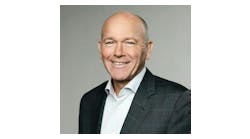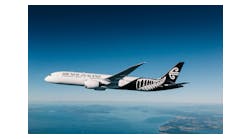A total of about six million aircraft were piloted through European airspace in 1995. Today, twenty years later, the number of aircraft movements in the same area has grown to nine million annually. The sky above Europe is overlaid with an elaborate network of routes for aircraft to follow. Despite this growth, the aviation industry is only responsible for 2.42 percent of worldwide CO2 emissions. To deal with further increases in the amount of traffic, sustainable solutions need to be found. The Free Route Airspace Maastricht and Karlsruhe project spanning the airspace over Belgium, Germany, Luxembourg and the Netherlands has been commended for saving tonnes of CO2 emissions and has been included in the Aviation Climate Solutions, a collection of hundred examples of how the aviation industry is collaborating to help reduce its impact on climate change.
This project offers a network of 466 cross-border direct route options. Using these routes, airlines can benefit from an annual reduction of route length of 1.5 million nautical miles which corresponds to a reduction of 30,000 tonnes of CO2 emissions. All in all, 9,000 tonnes of fuel can be saved.
Up to 80 percent of aircraft that can fly the direct routes actually use them. With these routes, airlines can plan more efficiently, less fuel has to be taken on board, and there are fewer deviations from flight plans.
The network was established in 2014 by the German air navigation service provider DFS Deutsche Flugsicherung in partnership with EUROCONTROL’s Maastricht Upper Area Control Centre (MUAC) and Lufthansa. The project was co-funded by the SESAR Joint Undertaking.
Klaus-Dieter Scheurle, CEO at DFS: "We are constantly working to provide airlines with more direct routings and improved procedures whenever possible, to help reduce CO2 emissions and protect the environment. FRAMaK has been an important step towards the full implementation of free route airspace within the Single European Sky".
Jac Jansen, Director of MUAC added: "In the past few years, we have made great efforts to inform airlines about the substantial environmental, financial and operational benefits that the free route network can offer them. This effort has resulted for some of our major customers into a 90 percent usage of direct routes, generating efficiencies for all parties and the network".
Sascha Unterbarnscheidt, Captain and Deputy Head of Flight Operations at Lufthansa: "Successfully implementing 466 cross-border direct routing options into daily operations has been a big step towards more efficiency and environmental benefits in European airspace, especially in one of Lufthansa’s centerpieces of flight operations. As an experienced airline operator, we were happy to contribute to this important improvement of airspace structure. "
Florian Guillermet, Executive Director of the SESAR Joint Undertaking: "Seeing is believing! We are delighted to see the work of this SESAR demonstration project recognised. It shows that the SESAR free route solution brings significant benefits in day to day operations. We look forward to seeing this solution deployed throughout Europe in the coming years. "
Aviation Climate Solutions was released on 29 September at the Global Sustainable Aviation Summit in Geneva, Switzerland. The industry is committed to stabilising its net CO2 emissions from 2020 through a concept called carbon-neutral growth, whereby traffic would continue to grow to meet the demands of society and the economy, but the growth would be offset by a global market-based measure. The longer-term goal is to actually reduce net CO2 emissions from aviation to half of the 2005 amounts by 2050.
In 2008, the aviation sector became the first industry to set global goals to proactively manage its climate change impact. At the same time, EUROCONTROL initiated the coordinated development and implementation of Free Route Airspace.
DFS Deutsche Flugsicherung GmbH, the German air navigation service provider, is a State-owned company under private law with 5,750 employees as at 30 June 2015. DFS ensures the safe and punctual flow of air traffic over Germany. Around 2,000 air traffic controllers guide up to 10,000 flights in German airspace every day, and about three million movements every year. This makes Germany the country with the highest traffic volume in Europe. The company operates control centres in Langen, Bremen, Karlsruhe and Munich as well as 16 control towers at international airports in Germany. In addition, DFS is represented at the EUROCONTROL Control Centre in Maastricht, the Netherlands. Additional areas of activity include consulting, provided by the Aeronautical Solutions Division, and aeronautical data, grouped in the Aeronautical Information Management Division. www.dfs.de
The Maastricht Upper Area Control Centre (MUAC), operated by EUROCONTROL on behalf of four States, provides control for the upper airspace (above 24,500 feet, i.e. approximately 7,500 metres) of Belgium, Luxembourg, the Netherlands and north-west Germany. The international area of responsibility it covers is a perfect example of the simplification and harmonisation of airspace in Europe. MUAC is a model for cross-border projects in the spirit of the Single European Sky. More than 1.6 million flights pass through MUAC’s area of responsibility each year, making it the third busiest air traffic control facility in Europe in terms of traffic volume. During the summer, peaks days see more than 5,200 flights.
The Lufthansa Group is a global aviation group with a total of around 540 subsidiaries and equity investments worldwide. The Lufthansa Group stands for quality and innovation, as well as for safety and reliability. The company is headquartered in Germany and is organized in four operating segments: Passenger Airline Group, Logistics, MRO, and Catering. All segments occupy a leading position in their respective markets. The Passenger Airline Group forms the company’s core business. Lufthansa Passenger Airlines, SWISS and Austrian Airlines are network carriers serving the global market and all passenger segments. Germanwings operates direct flights within Europe. Additionally, the company has interests in Brussels Airlines, JetBlue as well as in SunExpress. In 2014, the entire Group flew a total of 106 million passengers. Lufthansa, along with its Group members and Star Alliance partners, serves over 1,300 destinations worldwide. The Lufthansa Group employs around 119,000 members of staff worldwide. In the 2014 business year, it returned revenues totalling 30 billion euros. www.lufthansa.com
SESAR (Single European Sky Air Traffic Management Research) was set up to modernise and harmonise ATM systems through the definition, development and deployment of innovative technological and operational solutions. Established in 2007, the SESAR Joint Undertaking (SJU) is a public-private partnership which pools the knowledge and resources of the entire ATM community in order to define, research, develop and validate SESAR Solutions. Founded by the European Union and Eurocontrol, the SJU currently has 15 members who together with their partners and affiliate associations represent over 70 companies working in Europe and beyond. The SJU also works closely with staff associations, regulators, airport operators, and the scientific community. In 2014, the SESAR Deployment Manager (SDM), comprised of air navigation service providers, airlines and the SESAR-related Deployment Airport Operators Group (SDAG), coordinates the implementation of the EU’s Pilot Common Project, the first set of SESAR Solutions to be deployed in a synchronised and timely manner across Europe. www.sesarju.eu, www.sesardeploymentmanager.eu
The Air Transport Action Group is a coalition of organisations and companies throughout the air transport industry that drive the sustainable development of the air transport sector. Funding members include ACI, Airbus, ATR, Boeing, Bombardier, CANSO, CFM, Embraer, Honeywell Aerospace, GE, IATA, Pratt & Whitney, Rolls-Royce and Safran. www.atag.org




